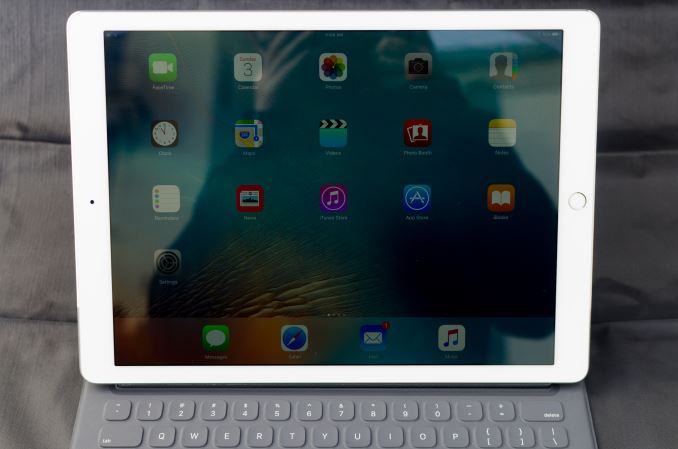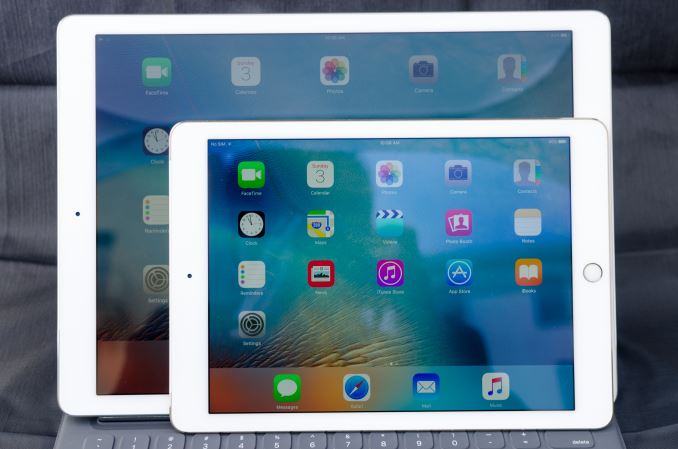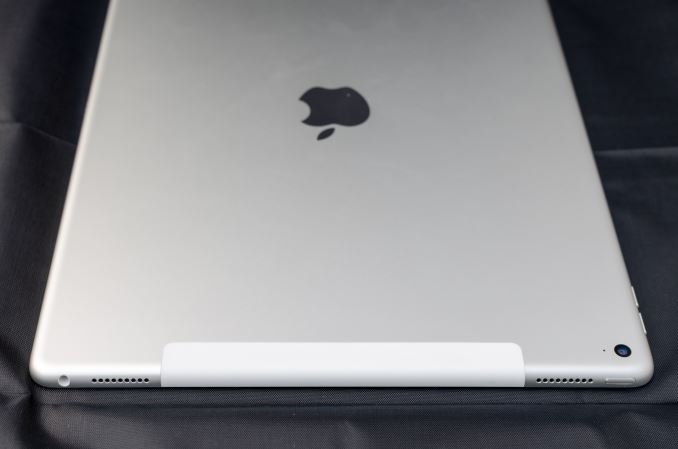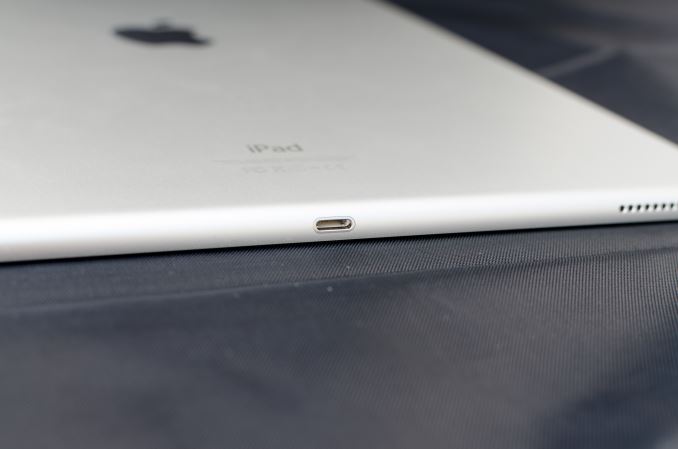The Apple iPad Pro Review
by Ryan Smith, Joshua Ho & Brandon Chester on January 22, 2016 8:10 AM EST
At this point it probably isn’t a secret that tablet sales have leveled off, and in some cases they have declined. Pretty much anywhere you care to look you’ll see evidence that the tablet market just isn’t as strong as it once was. It’s undeniable that touch-only tablets have utility, but it seems that the broader market has been rather lukewarm about tablets. I suspect at least part of the problem here is that the rise of the phablet has supplanted small tablets. Large tablets are nice to have, but almost feel like a luxury good when they’re about as portable as an ultrabook. While a compact laptop can’t easily be used while standing, or any number of other situations where a tablet is going to be better, a compact laptop can do pretty much anything a touch-only tablet can. A laptop is also going to be clearly superior for a significant number of cases, such as typing or precise pointing.
As a result, large touch-only tablets feel like they’ve been limited to home use as a computer away from the computer. Tablets are great when you’re on the couch or in bed, but once you get to this point there are some obvious questions as to whether it makes sense to drop $500+ USD on a tablet that seems to have relatively limited utility. The Surface lineup has been showing signs of growth, but in general the Surface is more of a mix between laptop and tablet rather than a tablet. I would argue that given the OS and overall design that the Surface and Surface Pro are really more laptop than tablet, even if at the hardware level the Surface Pro 4 and Surface 3 are basically tablets with kickstands and keyboard covers.
If you’re guessing that this means Apple has had some issues with growing sales of their iPad lineup, you’d be right. From my first experiences with the iPad 3, I was impressed with the improved user experience for things like web browsing and other smartphone tasks, but I never really felt like it made enough sense to get one for myself. The iPad Air 2 was once again impressive and I felt like I could recommend it to other people that wanted a tablet, but I personally struggled to come up with a reason why I would buy it.
This brings us to the iPad Pro. This is probably the first time Apple has seriously deviated from traditional iPad launches, putting together a tablet built for (limited) productivity and content creation rather than just simple content consumption, creating what's arguably the iPad answer to the Surface Pro. To accomplish this, Apple has increased the display size to something closer to that of a laptop, and we see the addition of a stylus and a keyboard cover for additional precision inputs. Of course, under the hood there have been a lot of changes as well, so the usual spec sheet can be found below to summarize those changes.
| Apple iPad Air 2 | Apple iPad Pro | |
| SoC | Apple A8X 3 x Apple Typhoon @ 1.5GHz |
Apple A9X 2 x Apple Twister @ 2.2GHz |
| GPU | PowerVR 8 Cluster Series6XT (Apple GXA6850) |
PowerVR 12 Cluster Series7XT |
| RAM | 2GB LPDDR3 | 4GB LPDDR4 |
| NAND | 16/64/128GB | 32/128GB |
| Display | 9.7" 2048x1536 IPS LCD | 12.9" 2732x2048 IPS LCD |
| Size and Mass | 240 x 169.5 x 6.1mm 437g WiFi, 444g LTE |
305.7 x 220.6 x 6.9 mm 713g WiFi, 723g LTE |
| Camera | 8MP Rear-Facing, f/2.4, 1.1 micron, 1.2MP Front-Facing, f/2.2 | |
| Battery | 27.3Wh | 38.5Wh |
| Launch OS | iOS 8 | iOS 9 |
| Cellular Connectivity | MDM9x25 Category 4 LTE + GPS/GNSS in Cellular SKU | |
| Other Connectivity | 2x2 802.11a/b/g/n/ac + BT 4.2, Apple Lightning | |
| SIM | Optional NanoSIM | |
| Price | $499/599/699 16/64/128GB | $799/949/1079 32/128GB/128GB LTE |
At a high level, the iPad Pro gains a larger display with a higher resolution, more memory, a new SoC, and a larger battery to compensate for the change in display size. In addition to these changes, the iPad Pro also brings noticeable changes to the speakers, with an increase to four speakers which allow the iPad Pro to compensate for device orientation when projecting stereo audio.
Design
The most immediate change that you can see in the iPad Pro is the sheer size. The 12.9” display of the iPad Pro basically makes it feel like you’re carrying a laptop around. I would argue that this doesn’t actually affect the portability of the iPad Pro, but this is mostly because the iPad Air 2 was something that I only carried in a backpack to begin with. People carrying their tablets in a small bag, purse, or even just in their hands will notice the difference, so the change in size might be more or less noticeable depending upon how you carry things around.
The increase in size does affect weight. After significant use, I honestly don’t think the mass is a significant issue. It does feel heavier than the iPad Air 2, but the mass distribution is such that there isn’t a ton of battery hanging out at the edges of the device where it’ll affect the moment of inertia. This does raise the question of whether Apple included enough battery for sufficient battery life, but that’s a question best left for the rest of the review.
In terms of design, the iPad Pro is rather unremarkable if you’ve ever seen an iPad Air before; it is for all intents and purposes a bigger iPad Air. On the front, the display dominates, with some bezels on the sides and top. The top has the front-facing camera, and the bottom has the home button with TouchID.
Looking at the sides of the tablet, the top edge has the power button and 3.5mm port, along with two of the four speakers. The right edge has the volume buttons, and the bottom edge has the Lightning port and the other two speakers. The left edge is mostly empty, but contains the Smart Connector for the Smart Keyboard and similar accessories.
The back of the tablet is mostly unremarkable as well. For the LTE model, an RF window is visible on the top of the device to allow LTE and other connectivity to function. For the WiFi variants, it looks like the bottom display bezel and the bottom two speakers are the RF windows, so there aren’t any visible areas that indicate where the WiFi antennas are.
Overall, the iPad Pro feels like an iPad, with nothing all that remarkable beyond its size which is carried well. I never really noticed the mass or size of the iPad Pro even if it is clearly larger and heavier than the iPad Air 2. I also didn’t notice any issues with the back cover flexing, but given enough pressure on the back cover pretty much any device this large will see some screen distortion or bending. The iPad Pro does technically regress in thickness compared to the iPad Air 2, but I never noticed the difference in practice, especially when the larger display is really what matters more.
















408 Comments
View All Comments
AirunJae - Wednesday, February 10, 2016 - link
Notice he said nothing about the iPad being better than the Surface, just that "...stop being a Fanboy" and "Surface Pro 4 wins" is ironic because you're following you plea for the reviewers (I assume) to stop being fanboys with some fanboyism of your own.MaxIT - Saturday, February 13, 2016 - link
Not running Windows make it better by definition....Delton Esteves - Wednesday, February 17, 2016 - link
Are you out of your mind? Not running full OS makes it worstdarwiniandude - Monday, February 29, 2016 - link
"Full OS"Drivers. Malware. Compatibility issues (install old piece of software, have it break new software). No low latency audio, audio not a priority. Any decent software is designed for mouse and keyboard, not tablet interface. For my purposes Surface is a waste of space. In fact we recently bought used a Surface 2 256GB for $100. Owner thought it was faulty. Wifi didn't work. Touch screen didn't work. Trackpad didn't work. Everything looked fine with the software config except there was malware. Wiped and reset up, works fine. But I can't use it for anything because the software I want to run isn't on Windows. The tablet ecosystem is elsewhere. Windows store is a joke. So it sits gathering dust.
Alecgold - Friday, February 12, 2016 - link
You've written a lot of BS.There is lighting to USB, so what is your point?
Lighting to hdmi adapter is available as well..
Lighting to memory card (with usb-3 speeds) is available
Kickstand is build in in the keyboard or smartcover.
Not everybody needs a pen, so why include it?
I don't need USB, HDMI, SD-cards or kick stands.
So why include it if you don't need it?
Keyboard is expensive indeed, but it's really good...
Who needs backlit, at night you need to sleep
I'm really annoyed by the trackpad on the surface, doesn't work when I want to, does work when I don't want to
Function keys are on the screen if needed or can be swiped up, not as convenient, but I prefer the small depth of the keyboard.
Why would I need to rest my hand? It rests on the table I'm writing on.
Setup was really fast an easy, what is complicated?
The iPad is a tablet so therefore it runs a mobile os, it has great battery life, I can do everything I need to. I just can't OCR PDF's, that is the only thing I still miss.
I'm a professional a consultant, I can do everything I need to, so there it is, it's used by a professional and therefore an iPad Pro. Just as good reasoning as yours, I guess.
Is the iPad Pro for anybody? Absolutely not. It's expensive, others need more processing power or bigger/better/more complete software. But if you can get by with it, I t's really a good device and a really good experience!
Delton Esteves - Wednesday, February 17, 2016 - link
Lighting to USB, lighting to hdmi adapter and lighting to memory card will cost you extra.The Kickstand which was built in the keyboard is very difficult to set up and has limited positions.
"Not everybody needs a pen". This is not a reason to charge for extra money.
Despite you do not need usb, hdmi, it does not mean they cannot include it. Because a device is made having in mind the general needs and not a single person needs.
You call yourself a Professional and yet you say "Who needs backlit". It seems like everybody has a definition of a Pro device this days.
So you always write on a table?
Writting and tapping on the screen is tiresome, function keys make you more productive.
Constructor - Saturday, February 20, 2016 - link
It is an illusion to believe that "included" items were in any way "free". In fact, for most people they would only pay more for stuff that they'd never use.On the bottom line everybody would have to pay more and there would be more electronic waste. Only the few people who actually used those add-ons might(!) get away slightly cheaper. That's it.
Delton Esteves - Tuesday, February 23, 2016 - link
But at least, they are not charging extra. If you consider Ipad Pro price you will notice that it is already expensive for what it is and what the majority of its Users will use it for. They are charging a lot for zero extra functionality.Constructor - Tuesday, February 23, 2016 - link
I have paid a little more for my iPad Pro than for my iPad 3 four years ago, and the iPad Pro is again a much better tablet than the iPad 3 had been (and it was already a very good one!).And I have paid extra for the Pencil which I actually wanted to use. Other users left the Penicl out and didn't have to pay for it. It's that simple and the way it should be.
So what exactly is the problem supposed to be with me paying for what I want to use, and others not paying for what they don't want to use? That's a really weird mindset from my point of view.
Delton Esteves - Wednesday, March 9, 2016 - link
They should lower Ipad pro price because Apple Pen does not come with it